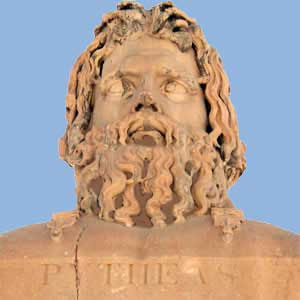The new thinkers of Asia Minor give the world a new dimension: Thales thinks that the earth is an island on the ocean. Anaximander develops a three-dimensional model. Herodotus draws a map of the world, with Greece as its centre. Pythagoras imagines celestial spheres. Aristote, finally, proves that the earth is round.
After the Egyptians and the Babylonians, it is on the shores of Asia Minor that the new concepts of the world are now being established. We are in the middle of the 7th century BC, at the time of the creation of Marseille. A large city, a large port, Miletus (Miletus) shines with its ideas. It creates a large number of colonies, in particular on the shores of the Black Sea and practices numerous exchanges with the whole of the known world (emporia)
Thales, born in 636 BC, is the first known name of the new generation of thinkers and scholars. From his various travels, particularly in Egypt, he brought back the basics of geometry. In a right triangle, the square of the hypotenuse is equal to the sum of the squares of the other two sides. This theorem is however attributed to Pythagoras. Did he steal it from him? He will also announce the solar eclipse of spring -585. He was above all the first to ask himself the following question: "What is the world made of?". Still influenced by Greek mythology, his answer will be: water, and his model is a flat earth floating on the ocean. .
Born in -610, and a contemporary of Thales, Anaximander thinks that matter cannot be a physical substance. It is "something indefinite and limitless". Matter is composed of oppositions, without physical properties, and in perpetual motion. Could this be the beginning of atomic physics? For him, the world is in eternal motion, at the center of a vortex, whose forces are in balance. It is like a sort of cylinder with a diameter 3 times its height, with a concave surface. It is on this surface that a map of the world is drawn. In the center, the Mediterranean; to the south Libya (Africa), with in the far south, an uninhabitable zone because of the heat; to the east the Indians; to the north Scythia (Russia), and further north the uninhabited zones because they are too cold. This map is surrounded by the outer ocean, the western part of which joins the Mediterranean by the Pillars of Hercules (Strait of Gibraltar).
 |
This bust of Pytheas is located next to the town hall of Marseille |
This is roughly the map of the world that Pytheas had for his journey. At the end of the 6th century BC, Pythagoras developed a model in which numbers are the basis of everything. The perfect forms are circles and spheres. The earth, the sun, the moon, and the other planets are spheres and describe circles around a central fire hidden from the earth.
Herodotus was born in -484 BC on the southern coast of Asia Minor (Halicarnassus). He traveled throughout the eastern Mediterranean and Egypt. He is told of a voyage around Africa: Pharaoh Necho II (-609-593 BC) is said to have armed a flotilla of Phoenician ships with the aim of circumnavigating Libya (Africa). This was done in 3 years. On their return, the sailors declared that "while sailing in the south of Libya, they had the sun on their right hand." This is proof that they had been to the south of Africa and passed into the southern hemisphere. For Herodotus, this allows him to accept that the ocean to the south is one between the Pillars of Hercules and the Indus Delta. To preserve the symmetry of the world, he thinks that the two great rivers known in the Mediterranean, the Nile and the Danube, have their source one at the foot of the Atlas and the other in the Pyrenees. Concerning the northern regions, Herodotus is more measured. He has heard of the Cassiterides Islands and the production of tin, as well as the Eridanus River from which amber comes, but wants to ignore this place.l’ambre, mais veut ignorer cet endroit.
360 / 5 000 But how can we explain the fact that new stars are visible when we travel south? And that some never set towards the north? Is the earth round? In the middle of the 4th century BC, that is to say at the time of Pytheas, Aristotle, observing the shadow of the earth on the moon during an eclipse, saw the shape of a crescent.
This is proof that the earth is round

